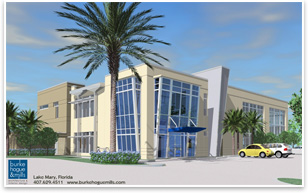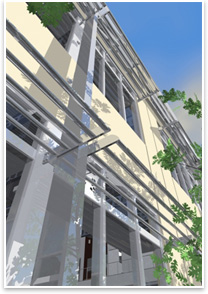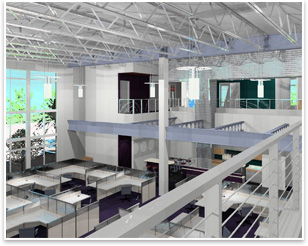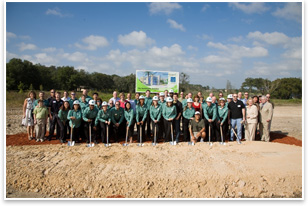BHM Designs Its Own New Headquarters Green
Sustainable office working toward LEED Silver in Florida
by Russell Boniface
Associate Editor
 How do you . . . show commitment to sustainable design through your own firm’s headquarters? How do you . . . show commitment to sustainable design through your own firm’s headquarters?
Summary: Burke Hogue Mills & Associates (BHM) broke ground last month in Seminole County, Fla., on its own new $4 million green headquarters. The BHM office is Seminole County’s first new green building, and first architecture-firm building in Florida working toward LEED® Silver certification. The 15,500-square-foot, two-story building, which can be expanded to 20,000 square feet, is expected to be completed in September 2008.
 The importance of a green headquarters The importance of a green headquarters
Bob Burke, AIA, BHM principal and chief executive officer, believes it is incumbent on architects to encourage clients to pursue sustainable design. “How can we expect our clients to agree to sustainability unless we’ve made some strides ourselves to walk the walk and talk the talk?” asks Burke. “Designing a green headquarters is a golden opportunity for us because it speaks to the public that this is the way to do it. It’s an architect leading by example ... we believe in it so much that we are doing it.”
LEED design features
BHM Principal Aranya Mom designed the two-level glazed building with the entry-corner glazing in BHM’s signature blue. The green design maximizes daylight, starting with its open, 4,500-square-foot design studio area, the primary space of the building. “We have an enormous amount of north light coming into the studio, and it will make the two-story space very creative and alive, especially in the wintertime,” says Burke. Indirect lighting will complement the natural light to create a soft workspace.
BHM partnered with mechanical engineer Gary Marchese to achieve the sustainable LEED-eligible features. Says Marchese, “I personally believe in trying to do the right thing for the Earth. We are burning too much energy in the United States, and we need to do better.”
 LEED-eligible features in the BHM office design include light shelves that will bounce light deeper into the studio and sunshades on the windows that will block direct glare and minimize solar heat gain. “We are meeting the requirements of interior daylighting, making sure all occupied spaces have the proper amount of connection to the outdoors,” Burke says. To further reduce heat gain, the team incorporated a special window film, “cool wall” exterior reflective paint, insulation between the building’s two exterior concrete panels, and a reflective roof to minimize heat island effect. LEED-eligible features in the BHM office design include light shelves that will bounce light deeper into the studio and sunshades on the windows that will block direct glare and minimize solar heat gain. “We are meeting the requirements of interior daylighting, making sure all occupied spaces have the proper amount of connection to the outdoors,” Burke says. To further reduce heat gain, the team incorporated a special window film, “cool wall” exterior reflective paint, insulation between the building’s two exterior concrete panels, and a reflective roof to minimize heat island effect.
Sustainable features continue throughout the headquarters to include:
- Rainwater harvesting for re-use (a scupper and downspout will direct rain water to an underground cistern)
- Automatic light controls and efficient lighting fixtures
- A raised access floor with under-floor air distribution system (unusual in Florida, explains Marchese) that will cool occupied spaces and remove contaminants from recirculated air
- Recycled or recyclable materials, including glass office countertops and cork walls in the lobby; materials also have low-emitting properties
- A chiller system for cooling
- High-efficiency air filters
- Waterless urinals and low-flow faucets
- A machine-room-less traction elevator that saves more energy as compared to hydraulic elevators
- Reflective concrete paving to reduce the heat island effect
- Reserved parking for low-emitting vehicles and a bike rack to encourage alternative transportation.
 A green attitude; tough questions A green attitude; tough questions
“We are just totally excited about the project,” enthuses Burke. “We are committed. The real proof will be in the savings to the environment.” Burke believes that respecting the environment should be representative of what architects are doing worldwide. “If we don’t adopt that attitude—in recycling, in picking the right materials, and reducing our carbon footprint—we won’t succeed and are being selfish because we are not thinking about future generations. That’s the reason our firm has taken this step and spent additional monies in design and evaluation of materials to do the right thing. It’s the one chance in my lifetime, and it had to be right, as well as right for our community.
 “My question is: How serious are we about the environment and how willing are we to put our own personal funds and resources where our mouths are? And the real question is: What does this initiative do to the program when we’re strapped for cash? So we are going to have to come up with some creative ways to deal with that, such as tax incentives and rebates from the power companies. It will be a challenge, but we have to make it work.” “My question is: How serious are we about the environment and how willing are we to put our own personal funds and resources where our mouths are? And the real question is: What does this initiative do to the program when we’re strapped for cash? So we are going to have to come up with some creative ways to deal with that, such as tax incentives and rebates from the power companies. It will be a challenge, but we have to make it work.”
Burke adds, “Green design is catching on like wildfire, and I think in 10 years architects shouldn’t have to convince anyone to design for basic LEED certification.”
|






